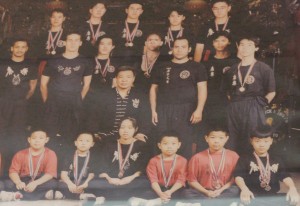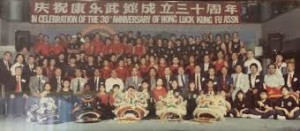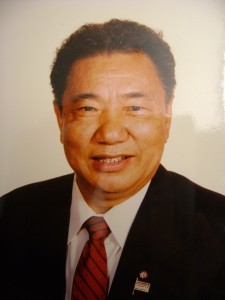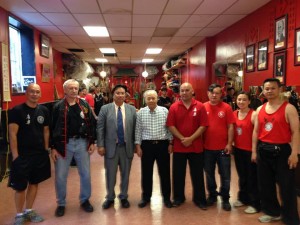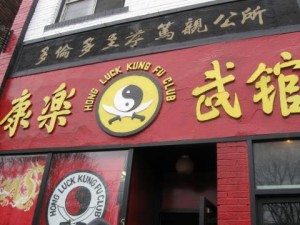History
The Hong Luck Kung Fu Club is, as the title gives away, a kung fu club located in Toronto’s Chinatown on Dundas Street. The club originated in 1961 On Elizabeth Street as a non profit organization. It was established by Grandmaster Paul Chan and Grandmaster Jin Chan. In 1968 members of the club chipped in money to purchase a bigger space on the corner of Spadina Avenue And Dundas Street where the club exists today. The club began with a membership of 13 men, just enough to cover rent and supplies. However, it quickly spread to 500 members with the support of the Chinese community behind them. Today, the Hong Luck Kung Fu Club is open to everyone.
(Grandmaster Paul Chan with successful competitors from a high-level tournament. Photograph. Heritage Toronto. Toronto Public Library, 6 Dec. 2012. Web. 5 Nov. 2009.)
(Group photo of club members, 1991, taken after a performance on the basement stage at the Chinatown Centre on Spadina, south of Dundas. Photograph. Heritage Toronto. Toronto Public Library, 6 Dec. 2012. Web. 5 Nov. 2009.)
Grandmaster Paul Chan and Jin Chan
Grandmaster Chan was often referred to as the “The Father of Canadian Kung Fu.” He was the founder, along with Grandmaster Jin Chan, of the Hong Luck Kung Fu Club and also a part of the Canadian Black Belt Hall of Fame. The name suits him as the Hong Luck Kung Fu Club is the oldest kung fu club in Canada. Unfortunately, in 2012, Grandmaster Paul Chan passed away at age 79. Grandmaster Jin Chan is currently 80 years old and still visits the club almost every day.
Grandmaster Paul Chan – (Grandmaster Paul Chan with successful competitors from a high-level tournament. Photograph. Heritage Toronto. Toronto Public Library, 6 Dec. 2012. Web. 5 Nov. 2009.)
Grandmaster Jin Chan, among other leaders – (“Leaders at Hong Luck 2014.” Photograph. “Hong Luck Kung Fu Club.” Facebook, 11 Aug. 2014. Web. 7 Apr. 2015.)
Reasons Behind the Hong Luck Kung Fu Club
The reason behind the kung fu club was due to two factors. Firstly, many Chinese men were experiencing verbal abuse and physical confrontations, and they wanted to be able to defend and protect themselves, as well as the community. The second reason is that the Chinese men wanted to have a place they could go and practice martial arts in a safe environment for explicitly Chinese people.
(Wai, Alan. Exterior of Hong Luck Kung Fu Club. Photograph. Alive Not Dead. Alive Not Dead, 2012. Web. 7 Apr. 2015.)
Works Cited
Grandmaster Paul Chan with successful competitors from a high-level tournament. Photograph. Heritage Toronto. Toronto Public Library, 6 Dec. 2012. Web. 5 Nov. 2009.
Group photo of club members, 1991, taken after a performance on the basement stage at the Chinatown Centre on Spadina, south of Dundas. Photograph. Heritage Toronto. Toronto Public Library, 6 Dec. 2012. Web. 5 Nov. 2009.
“In Memoriam: Grandmaster Paul Chan (1932-2012).” Photograph. Heritage Toronto. Toronto Public Library, 6 Dec. 2012. Web. 5 Nov. 2009.
“Leaders at Hong Luck 2014.” Photograph. “Hong Luck Kung Fu Club.” Facebook, 11 Aug. 2014. Web. 7 Apr. 2015.
Wai, Alan. Exterior of Hong Luck Kung Fu Club. Photograph. Alive Not Dead. Alive Not Dead, 2012. Web. 7 Apr. 2015.

